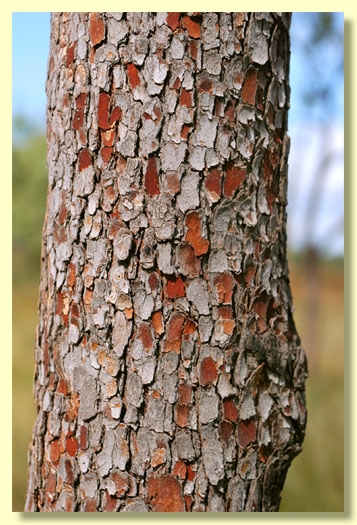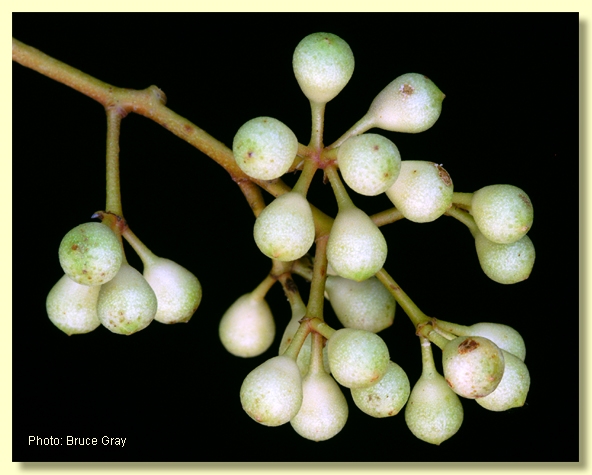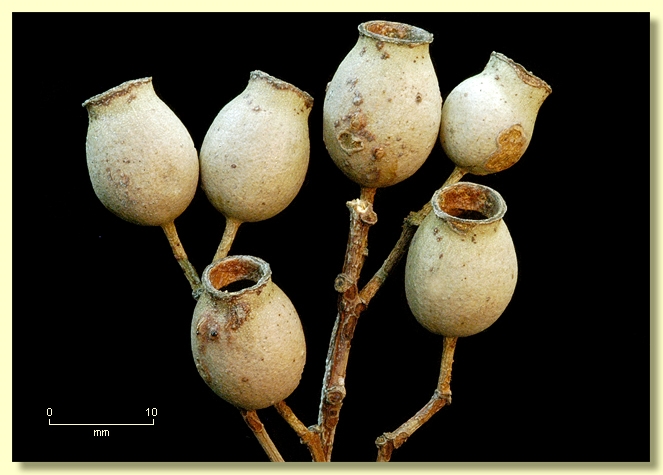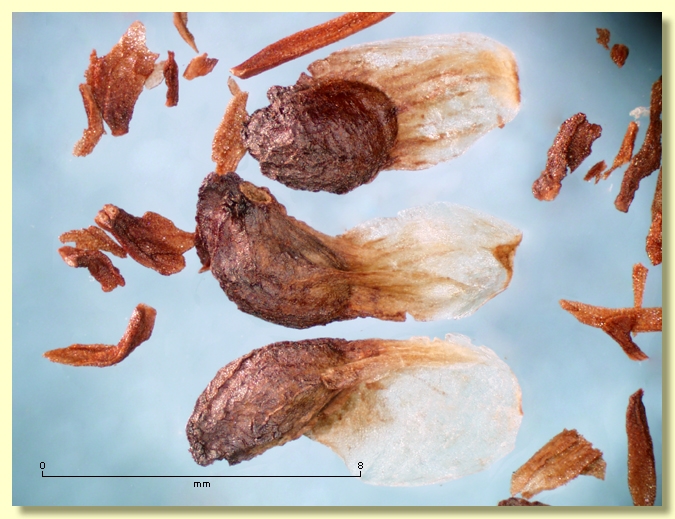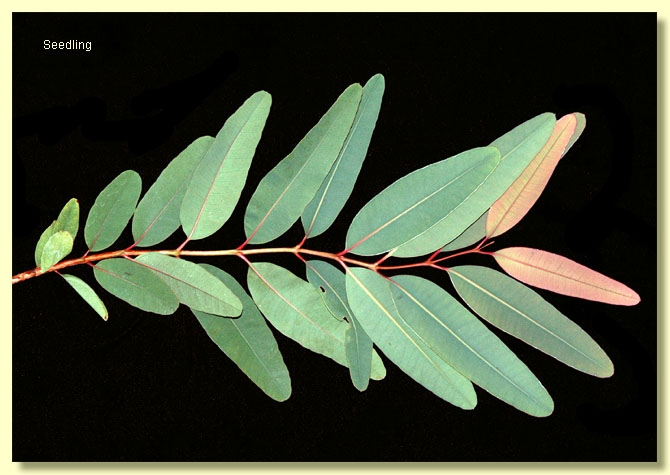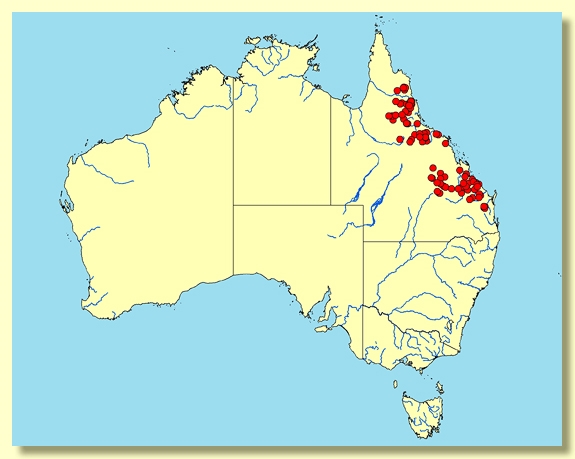Euclid - Online edition
Corymbia erythrophloia
Corymbia | Rufaria
Corymbia erythrophloia (Blakely) K.D.Hill & L.A.S.Johnson, Telopea 6: 304 (1995).
Eucalyptus erythrophloia Blakely, Key Eucalypts 80 (1934). T: Queensland: the old battery, Eidsvold, Sept. 1919, T.L.Bancroft s.n.; lecto: NSW 10065 (fide Carr & Carr (1985) p.30, but see extensive note Hill & Johnson (ibid., p. 304).
Tree to 8 m tall. Forming a lignotuber.
Bark rough over trunk and often larger branches and sometimes extending to smaller branches, but always of thin loose flakes which are grey-brown over rich red-brown in a tessellated pattern, the branches frequently very reddish flaky to white or cream and smooth.
Branchlets smooth (glabrous); elongated oil bodies occur in the pith.
Juvenile growth (coppice or field seedlings to 50 cm): stems square to rounded in cross-section, glabrous; juvenile leaves always petiolate, opposite for ca 20 nodes then becoming alternate, elliptical to ovate then lanceolate, 5.5–12.5 cm long, (1.7)2–5.5 cm wide, base rounded to tapering, apex rounded and apiculate or pointed, green, glabrous.
Adult leaves alternate, petioles 0.9–2.8 cm long; blade ovate or lanceolate, 9–23.6 cm long, (1)2–3.5 cm wide, base tapering to petiole, margin entire, apex pointed, concolorous or only slightly discolorous, dull, green, smooth, side-veins at greater than 45° to midrib (penniveined), reticulation dense to very dense, intramarginal vein not visible (confluent with margin) or visible but very close to margin in broader leaves, oil glands small, scattered, island or sometimes absent.
Inflorescence terminal compound, peduncles rounded, 0.4–2.1 cm long, buds 7 per umbel, pedicels slender, 0.3–1 cm long. Mature buds obovoid or pyriform, 0.6–1 cm long, 0.5–0.7 cm wide, smooth and shiny, scar absent (both opercula shed together at flowering), operculum shallowly rounded and apiculate or not, or flattened, stamens inflexed, all fertile, anthers oblong, dorsifixed, versatile, dehiscing by longitudinal slits, style as long as the floral cavity, straight, stigma mop-like, locules 3 or 4(5), the placentae each with ca 5 vertical ovule rows or the rows indistinct; flowers creamy white.
Fruit pedicellate (pedicels 0.3–1 cm long), urceolate to ± globular in outline, narrowed above to a distinct neck with the thin rim flared widely or rarely erect, 1.1–2.1 cm long, 1–1.6 cm wide, longer than wide (length 1.2–2 cm), surface smooth, disc descending vertically or sometimes obliquely, valves 3 or 4(5), enclosed.
Seeds brown, 6–10 mm long, ellipsoidal with terminal wing, hilum ventral.
Cultivated seedlings (measured at ca node 10): cotyledons large, reniform; stems rounded in cross-section, sparsely setose with long bristle-glands only for basal 3–5 nodes then glabrous, or sometimes virtually glabrous throughout; leaves always petiolate (petioles to 0.9 cm), opposite for at least 14 nodes but with occasional leaf pair sub-opposite, elliptical to ovate or oblong, sometimes broadly lanceolate, 5.5–12.5 cm long, 2–4 cm wide, base ± tapering to petiole, apex pointed or rounded, green, sparsely setose on both surfaces but especially on margins and midrib and then only to leaf-pair 3, glabrous thereafter.
Flowering has beeen recorded in January, February, March and April.
Small tree endemic to eastern Queensland and widespread in the Great Dividing Range from southern Cape York Peninsula south to the Atherton Tableland and associated ranges to the west, extending south to Greenvale, the White Mountains and Ayr. There is a disjunction in the distribution to the south with Corymbia erythrophloia occurring again near Clermont and extending south-west to the Carnarvon Ranges and nearby area and also south-east as far as Eidsvold (from where it was first described) and Kilkivan near Dalby. It is also found in ranges nearer the coast from Marlborough south to Miriam Vale and inland towards Biloela. C. erythrophloia is a component of open woodland areas on often heavy soils, clays and clay-loams overlying basalt and granite, on plains, gentle slopes and hillsides.
C. erythrophloia is a thinly rough-barked tree with a reddish character to the bark overall, the crown is made up of dull green leaves which are scarcely paler on the underside if at all, buds are pear-shaped, shiny and borne in terminal inflorescences whilst fruit are urn-shaped to barrel-shaped usually with conspicuous flared rim, and juvenile leaves on field coppice are ± elliptical-lanceolate, 2–5 cm wide and glabrous.
In the north of the species range it can be confused with its close relative C. ellipsoidea, a species of sandstone and quartzite hills where it grows on skeletal sandy soil. The preference of C. erythrophloia for clayey sites is the best guide to separating them, but they also differ in the width of seedling leaves measured at ca node 10, being 2–4 cm wide in this species and 0.5–1 cm in C. ellipsoidea. Other species with rough bark on the trunk that may be confused with C. erythrophloia include: C. pocillum which has smaller much more globular fruit, and occurs in the western Gregory and Newcastle Ranges, whilst C. clarksoniana, C. hylandii, C. stockeri, C. intermedia, C. polycarpa, C. serendipita and C. trachyphloia all differ from C. erythrophloia in having adult leaves that are conspicuously darker above and paler on the underside.
MORE ABOUT CORYMBIA
MORE ABOUT RED BLOODWOODS
Corymbia erythrophloia: Greek erythro, red and phloia bark, referring to the thin flaky rough bark which is frequently and, perhaps seasonally, predominantly red in colour.


